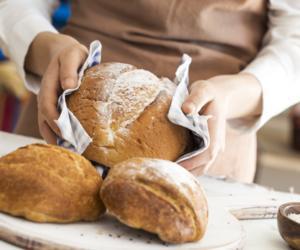Two Sisters Create a Resourceful Gluten-Free Website

Photo: Sara (left) and Emma (right) Kronenberg. Source: Eagle News Online.
Diagnosed at 3 years old with celiac disease, Sara Kronenberg and her family had to make some big changes to their diets and embrace a gluten-free lifestyle. Thanks to her mother’s support and research that she did about living gluten-free, Sara and her older sister Emma became experts at reading labels, making tasty foods and scoping out which places to get gluten-free treats in their community.
The sisters who are both very active with extra-curriculars had the opportunity to complete the requirements needed to earn the Silver Award with their respective Girl Scout troops. The Silver Award is one the highest awards for a girl scout to earn, and the recipients of this prestigious award must come up with a solution to a problem that affects people in their community.
Both girls put their heads together and decided that finding a way to help local families who are transitioning to a gluten-free lifestyle would be the perfect problem to solve. The solution? To build a resource that would provide information and tools needed to go gluten-free. The sisters did this by creating an in-depth information website that combined personal stories, the hard facts about going gluten-free and links to other resources
Through hard work and some learning on how to build a website, www.gfguiders.com was born. Visitors to the site will learn about the Kronenbergs' journey to a gluten-free lifestyle, how to handle social situations like birthday parties and other tips, tricks and even a few yummy recipes. It is a great resource for families who are dealing with conditions like celiac disease and transitioning to a gluten-free lifestyle.
What exactly is gluten-free?
The simple answer to this question is that gluten-free is basically a diet that is completely free of gluten or rather, the mixture of proteins that are commonly found in grains such as wheat, barley, rye, spelt, and kamut that make up gluten.
There are many commercially made substitutes that allow some mainstream food like cereals and boxed macaroni cheese to be labeled as gluten free however, a proper gluten-free diet should rely mainly on natural gluten free foods like meat, fish, eggs, milk and other dairy products, legumes, nuts, fruits, vegetables, potatoes, rice and maize.
Gluten is added to many different foods as a way to help it maintain its shape - almost like glue. Most people associate gluten with foods like breads, cereals and pastas but, gluten can be sneaky and is often added to foods and products like packages, sauces, salad dressing, food-coloring and even milkshakes!
Why go gluten-free?
This is a little trickier to answer. Some individuals make a personal dietary choice to go gluten-free based on mainstream diets or other research they have done on the benefits of eliminating gluten, while others, have no other option but to start eating gluten-free due to medical conditions such as celiac disease, non-celiac gluten sensitivity, wheat allergies and many others. For the Kronenburg family, it was the diagnosis of celiac disease when Sara was three that pushed them towards embracing a gluten-free lifestyle.
Whether doing it for personal reasons or to ensure a long and healthy life, transitioning to a gluten-free diet can be challenging. This can be especially hard for families with only one member of the family who has to eat gluten-free because doing the drive through thing when running late for swimming lessons can be a no go. With the right tools and information, though transitioning to a gluten-free diet or even learning to live with a disorder like celiac disease can be easier.
Celiac disease is an autoimmune disorder that basically causes the body to react to gluten - particularly wheat gluten. The main symptoms are usually gastrointestinal because gluten damages the small intestine, but celiac disease can also cause extreme fatigue and nutritional malabsorption, so basically it makes it so that the body doesn’t absorb any nutrition from the foods that are being consumed. Untreated celiac disease can cause a myriad of complications as celiac disease has been tied to itchy rashes on the skin, migraines and even disorders like multiple sclerosis and type 1 diabetes. At the moment, as many as two and half million Americans are dealing with undiagnosed celiac disease.
Although there is no known medical treatment for celiac disease, a lifelong gluten-free diet can keep many of the effects of the disease at bay. Maintaining a completely gluten-free diet is critical as ingesting even the smallest amount, like breadcrumbs that were not properly washed off the cutting board, can trigger intestinal damage with some pretty unpleasant results.
The importance of education
The sisters hope that their website will provide families transitioning to a gluten-free lifestyle with the right information. Because of their own gluten-free journey and the challenges that Sara has faced while battling celiac disease, both girls recognize the importance getting the right information out there. Unfortunately there are still many misconceptions about going gluten free and the reasons for it such as
- Gluten-free food is healthier. Replacing regular pasta and breads with their gluten-free counterparts does not in any way make them an healthier choice or reduce the amount of calories they have
- In the US alone, every 141 persons have celiac disease and if not treated with a specialized diet can lead to potentially fatal side effects.
- Going gluten-free is a choice. For a few people, yes, it is a choice but for many, giving up their beloved pastas, breads and even soy sauce has nothing to do with choice but rather with keeping themselves healthy.
- A celiac patient can still eat fast food if they avoid the bread. Even french fries can put a person with celiac disease at risk - no, potato does not contain gluten but often the oil that those fries are cooked in has been cross contaminated by other foods containing gluten, like the breading on chicken nuggets.
Gluten-free in social settings
The sister’s website provides visitors with examples of how to handle social situations and special occasions, particularly those that involve children like sleepovers, school snacks, Halloween and birthday parties. A good example of this is the sample letter that is displayed from a mother of a child who has celiac disease to their teacher. The letter provides the teacher with the information he or she may need about celiac disease and its effects and ways that school snacks and birthday celebrations can be handled. Information like this can really help a parent's plan ahead. It can be overwhelming having a child with a condition like celiac disease and seeing real life examples is one way to help a parent get prepared for things like sending their child to school or for their first time away at a sleep away camp.
Dealing with celiac disease and transitioning to a gluten free diet is challenging for anyone. Thanks to the creativity of two young sisters and their willingness to share their gluten-free journey, there is now a wonderfully informative website available to anyone who needs to be educated about living the gluten free life.












